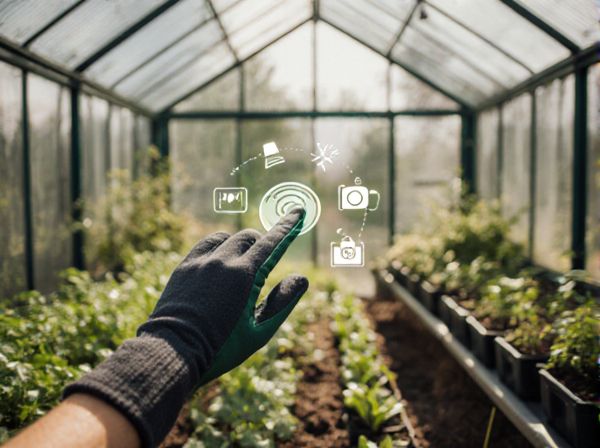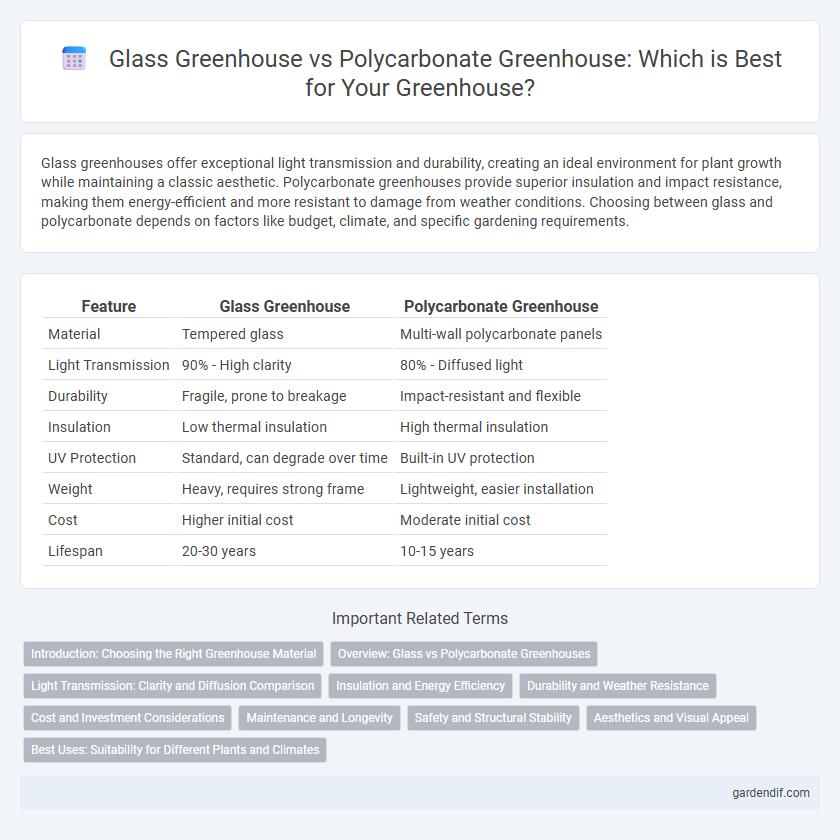
Glass Greenhouse vs Polycarbonate Greenhouse Illustration
Glass greenhouses offer exceptional light transmission and durability, creating an ideal environment for plant growth while maintaining a classic aesthetic. Polycarbonate greenhouses provide superior insulation and impact resistance, making them energy-efficient and more resistant to damage from weather conditions. Choosing between glass and polycarbonate depends on factors like budget, climate, and specific gardening requirements.
Table of Comparison
| Feature | Glass Greenhouse | Polycarbonate Greenhouse |
|---|---|---|
| Material | Tempered glass | Multi-wall polycarbonate panels |
| Light Transmission | 90% - High clarity | 80% - Diffused light |
| Durability | Fragile, prone to breakage | Impact-resistant and flexible |
| Insulation | Low thermal insulation | High thermal insulation |
| UV Protection | Standard, can degrade over time | Built-in UV protection |
| Weight | Heavy, requires strong frame | Lightweight, easier installation |
| Cost | Higher initial cost | Moderate initial cost |
| Lifespan | 20-30 years | 10-15 years |
Introduction: Choosing the Right Greenhouse Material
Selecting the right greenhouse material is essential for optimizing plant growth and durability. Glass greenhouses offer superior light transmission up to 90%, enhancing photosynthesis, while polycarbonate greenhouses provide exceptional impact resistance and thermal insulation, reducing heat loss by up to 30%. Understanding these material properties helps gardeners balance transparency, energy efficiency, and durability to create an ideal growing environment.
Overview: Glass vs Polycarbonate Greenhouses
Glass greenhouses offer superior light transmission, providing up to 90% clarity, which promotes optimal plant growth and photosynthesis. Polycarbonate greenhouses, while slightly less transparent with about 80% light transmission, provide enhanced impact resistance and better insulation due to their multi-wall design, reducing heat loss. The choice between glass and polycarbonate often depends on climate considerations, durability requirements, and energy efficiency priorities.
Light Transmission: Clarity and Diffusion Comparison
Glass greenhouses offer superior light transmission with clarity reaching up to 90%, allowing maximum sunlight penetration essential for photosynthesis. Polycarbonate greenhouses provide slightly lower light transmission, typically around 80-85%, but excel in light diffusion which reduces harsh shadows and promotes more even plant growth. The choice between glass and polycarbonate depends on balancing the need for clarity with the benefits of light diffusion in optimizing plant health.
Insulation and Energy Efficiency
Glass greenhouses provide excellent light transmission but have lower insulation properties, leading to higher heat loss during colder months. Polycarbonate greenhouses feature multi-wall panels that significantly improve thermal insulation, reducing energy costs for heating by retaining warmth more effectively. Enhanced energy efficiency in polycarbonate structures makes them more suitable for maintaining stable temperatures and promoting year-round plant growth.
Durability and Weather Resistance
Glass greenhouses offer excellent clarity and UV transmission but are more prone to breakage under hail, strong winds, or heavy snow, making them less durable in extreme weather conditions. Polycarbonate greenhouses provide superior impact resistance and flexibility, with multi-wall panels that enhance insulation and effectively withstand harsh weather, including heavy storms and fluctuating temperatures. The longevity and structural integrity of polycarbonate materials generally surpass glass, especially in regions with unpredictable climates.
Cost and Investment Considerations
Glass greenhouses typically require a higher initial investment due to the cost of tempered or laminated glass and the need for sturdy framing to support the weight, but they offer superior light transmission and durability over time. Polycarbonate greenhouses are more cost-effective upfront, with lower material and installation expenses, and provide excellent insulation and impact resistance, reducing energy costs. Investment decisions should weigh the long-term benefits of glass's longevity and clarity against polycarbonate's affordability and energy efficiency.
Maintenance and Longevity
Glass greenhouses require frequent cleaning and careful handling to prevent cracks, demanding more intensive maintenance compared to polycarbonate greenhouses. Polycarbonate panels offer superior durability and UV resistance, reducing the risk of damage and extending the structure's longevity by up to 10 years. Maintenance costs for polycarbonate greenhouses are generally lower due to their impact resistance and weatherproof properties, making them a cost-effective choice for long-term use.
Safety and Structural Stability
Glass greenhouses offer superior clarity and resistance to scratches but are more prone to shattering under impact, posing higher safety risks during severe weather. Polycarbonate greenhouses provide enhanced structural stability due to their impact-resistant and flexible panels, reducing the risk of breakage and injury. The multi-wall construction of polycarbonate also contributes to better insulation and durability, making it a safer choice in harsh climatic conditions.
Aesthetics and Visual Appeal
Glass greenhouses offer superior clarity and a classic, elegant appearance that enhances garden aesthetics with a sleek, transparent finish. Polycarbonate greenhouses feature a modern, versatile design with a slightly opaque surface that diffuses light evenly, reducing glare and hot spots. The choice between glass and polycarbonate impacts the overall visual appeal, with glass providing a more traditional, pristine look and polycarbonate offering a contemporary, softer aesthetic.
Best Uses: Suitability for Different Plants and Climates
Glass greenhouses offer superior light transmission, making them ideal for growing sun-loving plants like tomatoes and orchids in stable climates with minimal temperature fluctuations. Polycarbonate greenhouses provide enhanced insulation and impact resistance, suited for cooler or variable climates and plants requiring consistent warmth such as peppers and seedlings. Both materials support diverse gardening needs, with glass favoring high-light crops and polycarbonate excelling in energy efficiency and durability.
Glass Greenhouse vs Polycarbonate Greenhouse Infographic

 gardendif.com
gardendif.com